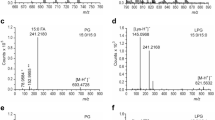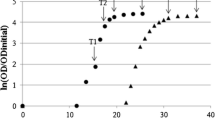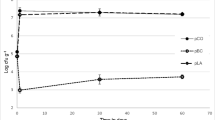Abstract
The effect of low pH on minimum pH, growth kinetics and adaptive response to acidity conditions were studied on nineEscherichia coli strains having food origin and two collection strains. Moreover, the effects of low pH on the modification of fatty acid (FA) composition and membrane fluidity of the strains were studied. Also the effects of a pre-adaptation to pH 5 on acidic resistance and FA composition were considered. The results showed the crucial role of unsaturated FA in acid adaptation ofE. coli. Cyclization and isomerization of membrane FA represented the most interesting response to acidic growth conditions in theE. coli strains considered. In particularcis/trans isomerization was shown to play an important role in modulating membrane composition and fluidity under acidic conditions. Only one strain was able to adapt to acidic stress increasing its ability to grow at low pH. It responded to pH decrease, conversely to each other strain, by increasing its membrane fluidity at the lowest pH values considered. The results obtained showed that the determination of membrane fluidity in intact whole cells by fluorescence polarisation can represent a useful tool to study instantaneous stress-induced membrane fluidity modifications.
Similar content being viewed by others
References
Aguedo M., Beney L., Waché Y., Belin J.-M. (2003). Mechanisms underlying the toxicity of lactone aroma compounds towards the producing yeast cells. J. Appl. Microbiol., 94: 258–265.
Akopyan K., Trchounian A. (2006).Escherichia coli membrane proton conductance and proton efflux depend on growth pH and are sensitive to osmotic stress. J. Cell Biochem. Biophys., 46: 201–208.
Álvarez-Ordóñez A., Fernández A., López M., Bernardo A. (2008). Relationship between membrane fatty acid composition and heat resistance of acid and cold stressedSalmonella senftenberg CECT 4384. Food Microbiol., 26: 347–353.
Bearson S., Bearson B., Foster J.W. (1997). Acidic stress responses in enterobacteria- minireview. FEMS Microbiol. Lett., 147: 173–180.
Brown M.H., Booth I.R. (1991). Acidulant and low pH. In: Russell N.J., Gould G.W., Eds, Food Preservatives. Bleckie, Glasgow, pp. 22–23.
Brown J.L., Ross T., McMeekin T.A., Nichols P.D. (1997). Acidic habituation ofEscherichia coli and the potential role of cyclopropane fatty acids in low pH tolerance. Int. J. Food Microbiol., 37: 163–173.
Chung H.J., Bang W., Drake M.A. (2006). Stress response ofEscherichia coli Compr. Rev. Food Sci. Food Saf., 5: 52–64.
Cronan J.E.Jr. (2002). Phospholipid modification in bacteria. Curr. Opin. Microbiol., 5: 2002–2005.
De Jonge R., Ritmeester W.S., Van Leusden F.M. (2003). Adaptive responses ofSalmonella enterica serovarTyphimurium DT104 and otherS. Typhimurium strains andEscherichia coli O157 to low pH environments. J. Appl. Microbiol., 94: 625–632.
Denich T.J., Beaudette L.A., Lee H., Trevors J.T. (2003). Effect of selected environmental and physico-chemical factors on bacterial cytoplasmic membranes. J. Microbiol. Methods, 52: 149–182.
Diefenbach R., Heipieper H.J., Keweloh H. (1992). The conversion ofcis intotrans unsaturated fatty acids inPseudmonas putida P8: evidence for a role in the regulation of membrane fluidity. Appl. Microbiol. Biotechnol., 38: 382–387.
Di Pasqua R., Hoskins N., Betts G., Mauriello G. (2006). Changes in membrane fatty acids composition of microbial cells induced by addiction of thymol, carvacrol, limonene, cinnamaldehyde, and eugenol in the growing media. J. Agric. Food Chem., 54: 2745–2749.
Di Russo C.C., Black P.N., Weimar J.D. (1999). Molecular in road into the regulation and metabolism of fatty acids, lessons from bacteria. Prog. Lipid Res., 38: 129–197.
Doyle M.P., Padhye V.V. (1989).Escherichia coli. In: Doyle M.P., Ed., Foodborne Bacterial Pathogens. Marcel Dekker, New York, pp. 235–281.
Gianotti A., Serrazanetti D., Sado Kamdem S., Guerzoni M.E. (2008). Involvement of cell fatty acid composition and lipid metabolism in adhesion mechanism ofListeria monocytogenes. Int. J. Food Microbiol., 123: 9–17.
Grogan D.W., Cronan J.E.Jr. (1997). Cyclopropane ring formation in membrane lipids of bacteria. Microbiol. Mol. Biol. Rev., 61: 429–441.
Guerzoni M.E., Lanciotti R., Cocconcelli P.S. (2001). Alteration in cellular fatty acid composition as response to salt, acid, oxidative and thermal stresses inLactobacillus helveticus. Microbiology, 147: 2255–2264.
Härtig C., Loffhagen N., Harms H. (2005). Formation oftrans fatty acids is not involved in growth-linked membrane adaptation ofPseudomans putida. Appl. Environ. Microbiol., 71: 1915–1922.
Heipieper H. J., Meulenbeld G., Van Oirschof O., De Bont J.A. (1996). Effect of environmental factors on thetrans/cis ratio of unsaturated fatty acids inPseudomonas putida S12. Appl. Environ. Microbiol., 62: 2773–2777.
Holtwick R., Meinhardt F., Keweloh H. (1997).Cis-trans isomerization of unsaturated fatty acids: cloning and sequencing of thecticti gene fromPseudomonas putida P8. Appl. Environ. Microbiol., 63: 4292–4297.
Hsu S.C., Tsen H.Y. (2001). PCR primers designed from malic acid dehydrogenase gene and their use for detection ofEscherichia coli in water and milk samples. Int. J. Food Microbiol., 64: 1–11.
Ku K.-L., Chiou J.-L., Liu F.-C, Chiou R.Y.-Y. (2007). Advanced gas chromatographic-mass spectrometric studies for identification of the cellular octadecenoate isomers and changes of fatty acid composition induced by ethanol stress inEscherichia coli andEscherichia coli O157:H7. J. Food Prot., 70: 616–622.
Maldonado B.-K., Schreiber E., Bhunia A.K., Nakatsu C.H. (2003). Subtyping of foodborne and environmental isolates ofEscherichia coli by multiplex-PCR, rep-PCR, PFGE, ribotyping and AFLP. J. Microbiol. Methods, 53: 387–399.
Morrison W.R., Smith L.M. (1964). Proportion of fatty acids methyl esters and methyl acetals from lipids with boron fluoride-methanol. J. Lipid Res., 5: 600–608.
Mykytczuka N.C.S., Trevors J.T., Leduca L.G., Ferroni G.D. (2007). Fluorescence polarization in studies of bacterial cytoplasmic membrane fluidity under environmental stress. Progr. Biophys. Mol. Biol., 95: 60–82.
Öksüz Ö., Arici M., Kurultay S., Gümüs T. (2004). Incidence ofEscherichia coli O157 in raw milk and white pickled cheese manufactured from raw milk in Turkey. Food Control, 15: 453–456.
Patrignani F., Iucci L., Belletti N., Gardini F., Guerzoni M.E., Lanciotti R. (2008). Effects of sub-lethal concentrations of hexanal and 2-(E)-hexenal on membrane fatty acid composition and volatile compounds ofListeria monocytogenes, Staphylococcus aureus, Salmonella enteritidis andEscherichia coli. Int. J. Food Microbiol., 123: 1–8.
Paul B., Hirshfield I. (2003). The effect of acidic treatment on survival and protein expression of a laboratory K-12 strainEscherichia coli. Res. Microbiol., 154: 115–121.
Riondet C., Cachon R., Wache Y., Alcaraz G., Diviès C. (1999). Changes in the proton-motive force inEscherichia coli in response to external oxidoreduction potential. Eur. J. Biochem., 262: 595–599.
Rowbury R.J., Goodson M. (1999). An extracellular acid stress-sensing protein needed for acidic tolerance induction. FEMS Microbiol. Lett., 174: 49–55.
Sainz T., Wacher C., Espinoza J., Centurion D., Navarro A., Molina J., Inzunza A., Cravioto A., Eslava C. (2001). Survival and characterization ofEscherichia coli strains in a typical Mexican acid-fermented food. Int. J. Food Microbiol., 71: 169–176.
Shabala L., Ross T. (2008). Cyclopropane fatty acids improveEscherichia coli survival in acidified minimal media by reducing membrane permeability ti H+ and enhanced ability to extrude H+ Res. Microbiol., 159: 458–461.
Slavik J. (1993). Fluorescent Probes in Cellular and Molecular Biology. CRC Press, Ann Arbor, MI, pp. 40–41.
Suutari M., Linkkonen K., Laakso S. (1990). Temperature adaptation in yeast: the role of fatty acids. J. Gen. Microbiol., 136: 1469–1474.
Tourdot-Marechal R., Gaboriau D., Beney L., Divies C. (2000). Membrane fluidity of stressed cells ofOenococcus oeni. Int. J. Food Microbiol., 55: 269–273.
Yuk H., Marshall D.L. (2004). Adaptation ofEscherichia coli O157:H7 to pH alters membrane lipid composition, verotoxin secretion, and resistance to simulated gastric fluid acid. Appl. Environ. Microbiol., 70: 3500–3505.
Yuk H., Marshall D.L. (2005). Influence of acetic, citric, and lactic acids onEscherichia coli O157:H7 membrane lipid composition, verotoxin secretion, and acid resistance in simulated gastric fluid. J. Food Prot., 68: 673–679.
Zwietering M.H., Jongenberger I., Roumbouts F.M., Van’t Riet K. (1990). Modelling of bacterial growth curve. Appl. Environ. Microbiol., 56: 1875–1881.
Author information
Authors and Affiliations
Corresponding author
Rights and permissions
About this article
Cite this article
Gianotti, A., Iucci, L., Guerzoni, M.E. et al. Effect of acidic conditions on fatty acid composition and membrane fluidity ofEscherichia coli strains isolated from Crescenza cheese. Ann. Microbiol. 59, 603–610 (2009). https://doi.org/10.1007/BF03175152
Received:
Accepted:
Issue Date:
DOI: https://doi.org/10.1007/BF03175152




